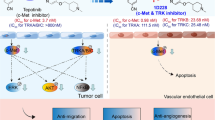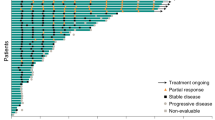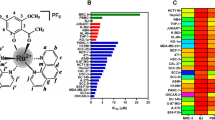Abstract
Thioredoxin reductase (TrxR) is a component of several redox-sensitive signaling cascades that mediate important biological processes such as cell survival, maturation, growth, migration and inhibition of apoptosis. The expression levels of TrxR1 in some human carcinoma cell lines are nearly 10 times higher than those in normal cells. Ethaselen is a novel antitumor candidate that exerts potent inhibition on non-small cell lung cancer (NSCLC) by targeting TrxR. In this study we explored the relationship between the ethaselen dose and TrxR activity level and the relationship between TrxR degradation and tumor apoptosis in a human lung carcinoma A549 xenograft model. BALB/c nude mice implanted with human NSCLC cell line A54 were administered ethaselen (36, 72, 108 mg·kg−1·d−1, ig) or vehicle for 10 d. The tumor size and TrxR activity levels in tumor tissues were daily recorded and detected. Based on the experimental data, NONMEM 7.2 was used to develop an integrated dose-biomarker-response model for describing the quantitative relationship between ethaselen dose and tumor eradication effects. The time course of TrxR activity levels was modeled using an indirect response model (IDR model), in which the influence of the tumor growth rates on Kin with the linear correction factor γ1 (0.021 d/mm). The drug binding-inhibition effects on Kout was described using a sigmoidal Emax model with Smax (5.95), SC50 (136 mg/kg) and Hill's coefficient γ2 (2.29). The influence of TrxR activity inhibition on tumor eradication was characterized by an Emax model with an Emax (130 mm3/d) and EC50 (0.0676). This model was further validated using a visual predictive check (VPC) and was used to predict the efficacy of different doses. In conclusion, the properties and characteristics of ethaselen acting on TrxR degradation and subsequently resulting in tumor apoptosis are characterized by the IDR model and integrated dose-biomarker-response model with high goodness-of-fit and great predicative ability. This approach shed new light on the detailed processes and mechanism of ethaselen action and may offer a valuable reference for an appropriate dosing regimen for use in further clinical applications.
Similar content being viewed by others
Log in or create a free account to read this content
Gain free access to this article, as well as selected content from this journal and more on nature.com
or
References
Powis G, Mustacich D, Coon A . The role of the redox protein thioredoxin in cell growth and cancer. Free Radic Biol Med 2000; 29: 312–22.
Mustacich D, Powis G . Thioredoxin reductase. Biochem J 2000; 346: 1–8.
Jakupoglu C, Przemeck GK, Schneider M, Moreno SG, Mayr N, Hatzopoulos AK, et al. Cytoplasmic thioredoxin reductase is essential for embryogenesis but dispensable for cardiac development. Mol Cell Biol 2005; 25: 1980–8.
Conrad M, Jakupoglu C, Moreno SG, Lippl S, Banjac A, Schneider M, et al. Essential role for mitochondrial thioredoxin reductase in hematopoiesis, heart development, and heart function. Mol Cell Biol 2004; 24: 9414–23.
Arner ES, Holmgren A . The thioredoxin system in cancer. Semin Cancer Biol 2006; 16: 420–6.
Bahn YS, Hicks JK, Giles SS, Cox GM, Heitman J . Adenylyl cyclase-associated protein Aca1 regulates virulence and differentiation of Cryptococcus neoformans via the cyclic AMP-protein kinase A cascade. Eukaryotic Cell 2004; 3: 1476–91.
Fang J, Lu J, Holmgren A . Thioredoxin reductase is irreversibly modified by curcumin: a novel molecular mechanism for its anticancer activity. J Biol Chem 2005; 280: 25284–90.
Zhang W, Zheng X, Wang X . Oxidative stress measured by thioredoxin reductase level as potential biomarker for prostate cancer. Am J Cancer Res 2015; 5: 2788–98.
Yan C, Shieh B, Reigan P, Zhang Z, Colucci MA, Chilloux A, et al. Potent activity of indolequinones against human pancreatic cancer: identification of thioredoxin reductase as a potential target. Mol Pharmacol 2009; 76: 163–72.
Nguyen P, Awwad RT, Smart DD, Spitz DR, Gius D . Thioredoxin reductase as a novel molecular target for cancer therapy. Cancer Lett 2006; 236: 164–74.
Wang L, Yang Z, Fu J, Yin H, Xiong K, Tan Q, et al. Ethaselen: a potent mammalian thioredoxin reductase 1 inhibitor and novel organoselenium anticancer agent. Free Radic Biol Med 2012; 52: 898–908.
Xing FX, Li SL, Ge XY, Wang CY, Zeng HH, Li D, et al. The inhibitory effect of a novel organoselenium compound BBSKE on the tongue cancer Tca8113 in vitro and in vivo. Oral Oncol 2008; 44: 963–69.
Shi C, Yu L, Yang F, Yan J, Zeng H . A novel organoselenium compound induces cell cycle arrest and apoptosis in prostate cancer cell lines. Biochem Biophys Res Commun 2003; 309: 578–83.
Zhao F, Yan J, Deng SJ, Lan LX, He F, Kuang B, et al. A thioredoxin reductase inhibitor induces growth inhibition and apoptosis in five cultured human carcinoma cell lines. Cancer Lett 2006; 236: 46–53.
Wang L, Fu JN, Wang JY, Jin CJ, Ren XY, Tan Q, et al. Selenium-containing thioredoxin reductase inhibitor ethaselen sensitizes non-small cell lung cancer to radiotherapy. Anticancer Drugs 2011; 22: 732–40.
Fu JN, Li J, Tan Q, Yin HW, Xiong K, Wang TY, et al. Thioredoxin reductase inhibitor ethaselen increases the drug sensitivity of the colon cancer cell line LoVo towards cisplatin via regulation of G1 phase and reversal of G2/M phase arrest. Invest New Drugs 2011; 29: 627–36.
Xiong K, Xu W, Zeng H . Reactive oxygen species mediate ethaseleninduced rapid apoptosis in A549 cells. J Chin Pharm Sci 2014; 23: 54–9.
Bretz F, Pinheiro JC, Branson M . Combining multiple comparisons and modeling techniques in dose-response studies. Biometrics 2005; 61: 738–48.
Bornkamp B, Bretz F, Dmitrienko A, Enas G, Gaydos B, Hsu CH, et al. Innovative approaches for designing and analyzing adaptive dose-ranging trials. J Biopharm Stat 2007; 17: 965–95.
Tan H, Gruben D, French J, Thomas N . A case study of model-based Bayesian dose response estimation. Stat Med 2011; 30: 2622–33.
Lowe PJ . Applying physiological and biochemical concepts to optimize biological drug development. Clin Pharmacol Ther 2010; 87: 492–6.
Gabrielsson J, Weiner D . Pharmacokinetic and pharmacodynamic data analysis: concepts and applications. Stockholm Swedish Pharmaceutical Press. 2007.
Jacobs T, Straetemans R, Molenberghs G, Adriaan Bouwknecht J, Bijnens L . A latent pharmacokinetic time profile to model dose-response survival data. J Biopharm Stat 2010; 20: 759–67.
Jackson RC . Pharmacodynamic modelling of biomarker data in oncology. ISRN pharmacol 2012; 2012: 590626.
Sarker D, Workman P . Pharmacodynamic biomarkers for molecular cancer therapeutics. Adv Cancer Res 2007; 96: 213–68.
He J, Li DD, Xiong K, Ge YJ, Jin HW, Zhang GZ, et al. Inhibition of thioredoxin reductase by a novel series of bis-1,2-benzisoselenazol-3(2H)-ones: organoselenium compounds for cancer therapy. Bioorg Med Chem 2012; 20: 3816–27.
Urig S, Becker K . On the potential of thioredoxin reductase inhibitors for cancer therapy. Semin Cancer Biol 2006; 16: 452–65.
Zeng HH, Wang LH . Targeting thioredoxin reductase: anticancer agents and chemopreventive compounds. Med Chem 2010; 6: 286–97.
Hashemy SI, Ungerstedt JS, Zahedi Avval F, Holmgren A . Motexafin gadolinium, a tumor-selective drug targeting thioredoxin reductase and ribonucleotide reductase. J Biol Chem 2006; 281: 10691–7.
Holmgren A, Bjornstedt M . Thioredoxin and thioredoxin reductase. Meth Enzymol 1995; 252: 199–208.
Smith AD, Guidry CA, Morris VC, Levander OA . Aurothioglucose inhibits murine thioredoxin reductase activity in vivo. J Nutr 1999; 129: 194–8.
Jusko WJ, Ko HC . Physiologic indirect response models characterize diverse types of pharmacodynamic effects. Clin Pharmacol Ther 1994; 56: 406–19.
Norton L, Simon R . Growth curve of an experimental solid tumor following radiotherapy. J Natl Cancer Inst 1977; 58: 1735–41.
Bissery MC, Vrignaud P, Lavelle F, Chabot GG . Experimental antitumor activity and pharmacokinetics of the camptothecin analog irinotecan (CPT-11) in mice. Anticancer Drugs 1996; 7: 437–60.
Zimanyi CM, Chen PY, Kang G, Funk MA, Drennan CL . Molecular basis for allosteric specificity regulation in class Ia ribonucleotide reductase from Escherichia coli. Elife 2016; 5: e07141.
Aye Y, Li M, Long MJC, Weiss RS . Ribonucleotide reductase and cancer: biological mechanisms and targeted therapies. Oncogene 2015; 34: 2011–21.
Sengupta R, Holmgren A . Thioredoxin and glutaredoxin-mediated redox regulation of ribonucleotide reductase. World J Biol Chem 2014; 5: 68–74.
Fang Z, Gong C, Liu H, Zhang X, Mei L, Song M, et al. E2F1 promote the aggressiveness of human colorectal cancer by activating the ribonucleotide reductase small subunit M2. Biochem Biophys Res Commun 2015; 464: 407–15.
Xu CW, Wang G, Wang WL, Gao WB, Han CJ, Gao JS, et al. Association between epidermal growth factor receptor mutations and the expression of excision repair cross-complementing protein 1 and ribonucleotide reductase subunit M1 mRNA in patients with non-small cell lung cancer. Exp Ther Med 2015; 9: 880–4.
Fu Y, Yang N, Yueqin L, Zhao Y, Ye S, Liu L, et al. Evaluation of thioredoxin reductase as a novel biomarker in the diagnosis and treatment of breast cancer. J Chin Pharm Sci 2014; 23: 711–15.
Ye S, Yang N, Ma W, Fu Y, Wu L, Li Y, et al. Prospective clinical application of thioredoxin reductase as a novel diagnostic tumor marker. J Biosci Med 2014; 2: 44–53.
Acknowledgements
This work was supported in part by the National Natural Science Foundation (81372266) and the National Science and Technology Major Project, China (2011zx09101-001-03).
Author information
Authors and Affiliations
Corresponding authors
Rights and permissions
About this article
Cite this article
Ye, Sf., Li, J., Ji, Sm. et al. Dose-biomarker-response modeling of the anticancer effect of ethaselen in a human non-small cell lung cancer xenograft mouse model. Acta Pharmacol Sin 38, 223–232 (2017). https://doi.org/10.1038/aps.2016.114
Received:
Accepted:
Published:
Issue date:
DOI: https://doi.org/10.1038/aps.2016.114
Keywords
This article is cited by
-
Oxidative stress in cancer: from tumor and microenvironment remodeling to therapeutic frontiers
Molecular Cancer (2025)
-
Toxicology and pharmacology of synthetic organoselenium compounds: an update
Archives of Toxicology (2021)
-
Drug Exposure to Establish Pharmacokinetic–Response Relationships in Oncology
Clinical Pharmacokinetics (2020)



